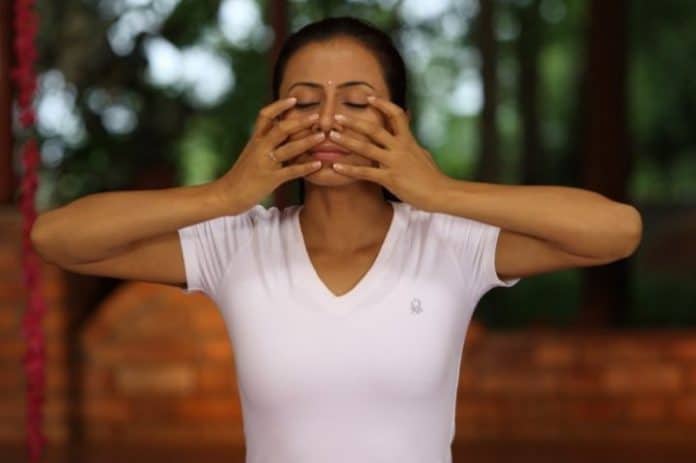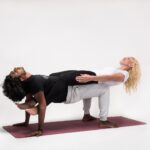Shanmukhi Mudra is a simple practice to inward the awareness (that usually flows out) by closing our sense of perception. On doing this, a seeker can see a clearer picture of their ‘thought patterns’ – Known as Vrittis in yoga.
Among different types of yoga mudras, this mudra is a part of Mana Mudra which is usually seen as the active involvement of ears, nose, eyes, tongue, and lips.
A literal translation of Shanmukhi gives a better picture of what exactly is this mudra and what happens in its practice.
What Does Shanmukhi Mudra Means?
The two root terms Shan and Mukhi combine to become Shanmukhi. Mukhi means “Face,” while Shan means “Six.” The serpent deity Six Faces Goddess summons Shanmukhi.
Shanmukhi refers to six openings through which we perceive the outside world or through which our awareness is dispersed in the context of mudra. There are 2 ears, 2 eyes, 2 eyeballs, and 6 apertures in total.
The doors to using the body’s five senses to perceive the outside world are these six entrances. in the mudra of Shanmukhi.
- We suppress hearing through the ears.
- We restrict the sense of sight through our eyes.
- Through the nose, we suppress our perception of scent.
- We can suppress our senses of touch and taste by using our mouths.
How to Do?
To perform the Shanmukhi Mudra, just adhere to these easy steps:
- Find a quiet area and take a comfortable cross-legged seat. If you wish to incorporate meditation with this, Padmasana and Veerasana are advised.
- Sit up straight, breathing normally. Before you disengage, let yourself sense the environment.
- Now, raise your arms with your palms facing you and your elbows raised to shoulder height. Start now by gradually closing each sense organ with a finger.
- Thumbs should be used to gently press the tragus, a portion of the outer earlobe, to close the ears.
- Before you close your eyes with your forefingers, roll your eyes upward.
- Middle fingers should be used to partially cover the nose.
- After that, put your ring and little finger in the space between your upper and lower lips, where the higher lip is just barely pressing against the lower one (these two adds in a symbolic way).
- Hold your breath as you inhale deeply with slightly closed nostrils. You are now removed from the unpleasant environment and are attempting to direct your attention to your breathing.
- You are delving more deeply into the world of your subtle inner being with each inhalation and exhalation. You might pick up on very small vibrations or sounds. As you concentrate on the Ajna chakra, you might see the spectrum’s brightness as a pitch-black space filled with vibrant rays.
- After a short period of practice, come back by exhaling and opening all of your senses. As you continue with the practice, you will start to see the beauty of nature and how it functions, which will improve your moral attitude toward it.
How Shanmukhi Mudra Works?
In Yoga Sutra, Patanjali Says,
Such a strategy that addresses these unsteady ideas is the Shanmukhi mudra.
This Mudra shapes a practitioner’s spiritual personality over time while also stimulating sense organs, enhancing concentration, and working on their subtle nature.
When we stop our sense organs in this mudra, our consciousness temporarily becomes disconnected from the outside world. Such a strategy offers the seeker a deeper understanding of oneself. The awareness gained by blocking out the outside environment amplifies the inward look required for meditation.
In order to engage in the highest forms of Dharana and Dhyana practice, pratyahara, or the withdrawal of senses, must be practiced. The Shanmukhi Mudra is the best approach to having a spiritual journey experience.
Shanmukhi Mudra Benefits
- Holding your breath after inhaling the Shanmukhi mudra revitalizes your skin’s shine and brings out its inherent attractiveness.
- Additionally, calming the neurological system reduces the sensation of motion sickness or vertigo.
- By combining Bhramari breathing with this mudra, presbycusis (age-related hearing loss) and dementia in old age can be treated. [efn note] Pranayama Bhramari (Shanmukhi Mudra) for dementia and presbyacusis
- Pratyahara, a state of withdrawn senses, is the result of this mudra. The only way to achieve a deeper level of meditation is by replicating true Pratyahara.
- The practitioner’s hearing is enhanced by the Shanmukhi mudra [efn note]. Yoga for Improving Hearing Performance
- It improves the efficiency of all sense organs to a greater level, enabling us to perceive our environment.
- It improves the practitioner’s attentional skills, such as motivation, self-esteem, sensory integration, practice, language challenges, and any existing diagnoses, because it resembles bhramari breathing. Effect of Yogic Breathing on Six-letter Cancellation Test Accommodation for Students with Visual Impairmenthttps://www.ncbi.nlm.nih.gov/pmc/articles/PMC5934945/
- Shanmukhi Mudra is also practiced under the kundalini yoga to awaken the dormant spiritual energy at the root (Muladhara) chakra. This further leads to deeper meditation.
- The Shanmukhi mudra has a relaxing impact that lowers tension, anxiety, hostility, and irritable behavior in people of all ages. [efn note] Shanmukhi Mudra and Pranayama Significantly Reduce Children’s Anxiety Levels, 12 to 13 Years Old http://www.indianjournals.com/ijor.aspx?target=ijor:ijpesmys&volume=6&issue=2&article=006 [/efn_note]
Precautions & Contraindications
- Beginners strive to stay away from prolonged or severe practice. Because it requires simultaneous coordination between several organ systems.
- The practice of the Shanmukhi mudra should be avoided by any practitioner who has recently undergone significant surgery or sustained an accident.
- Avoid firmly pressing the tragus of the ear since this could be dangerous. Gently place your forefingers over your eyes and slightly cover your nose after that.
- Pregnant women are not advisable to practice this mudra alone. However, it can be practiced along with low-pitch Bhramari pranayama.
- A practitioner who has hypertension should refrain from holding their breath for extended periods as it may result in heart failure, cardiac arrest, etc.
- Additionally, people with respiratory problems like bronchitis, chronic obstructive pulmonary disease (COPD), and asthma should avoid holding their breath for extended periods of time.
Faq’s on Shanmukhi mudra
Which chakra becomes activated by Shanmukhi mudra?
Shanmukhi mudra causes the Ajna chakra, which is situated in the middle of our forehead, to become active. It is about halfway between the brows. Although not a physical organ, the Ajna chakra is still regarded as a component of the yogic system.
How long does to practice Shanmukhi mudra?
Practice for 3-5 minutes at a stretch to get the most effective. Continue for 7–10 minutes after you feel comfortable but not at first.
Does Shanmukhi mudra really work?
The Shanmukhi Mudra blocks away the feelings and activities of the outside world. Additionally, it is used to control stress, anxiety, and rage. You will start to experience changes in yourself after a month of consistent practice. Instead of getting irritated like previously, you’ll develop into a chill person that is worth hanging out with.
Why life energy should be inwardly directed?
A person’s overall quality is improved when they focus their life energy inward. Your strategy and focus will drastically alter. You’ll be better able to respond impulsively when the occasion arises.
Conclusion
For each and every one of us, life energy is extremely valuable. You’ll see changes both outside of you and inside of you once you know how to channel life force for your own advancement. Therefore, channeling within direction instead of wasting time-fighting or arguing by doing the Shanmukhi mudra will result in a brand-new creation for you.





















